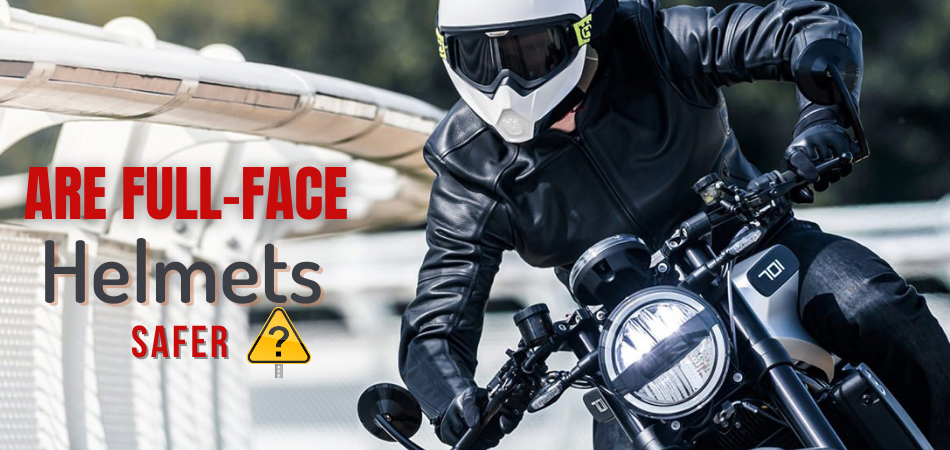The thrill of the wild breeze against your face while riding a bike is almost priceless. However, such luxury comes with the price of not riding on a safe, compatible motorcycle and protective gear. Helmets are very pivotal to the safety of motorbikers. They protect the brain from injury and death.
Moreover, research shows that over 34.6% of crash impacts affect the chin. This means that, for every 100 motorbike accidents that happen, over 34% of those bikers are very likely to hit their chin against the ground.
While helmets prove to be very effective in preventing head injuries, their level of effectiveness varies. It’s not every helmet that guarantees total safety from crash accidents.
But there are three types of helmet designs, of which some bikers prefer using open-faced helmets, while the rest prefer the full-faced ones. The question now is, are full face helmets safer than others? This article will help you explore the safest helmet for bikers.
Are Full Face Helmets Safer?
While there are several types of helmets, there are only three kinds of helmet designs: open-face, modular, and full-face helmets. But amid the three helmet designs, are full-face helmets safer than the rest? They are safer since they protect everything above your neck, from the skull to the chin.

1. The Full-face Helmet
The full-face helmet came into the picture in the 1960s. As the name implies, the full-face helmet provides full protection to the head. It covers the chin and has a transparent glass or plastic called a “visor” that swings open for proper ventilation.
Full-face helmets are more secure than all other kinds of helmets because of the staggering 34.6% damage possibility on the chins. However, these helmets are the heaviest, and thus they cause aches on the shoulders and necks of long-distant riders.
The full-face helmet is a perfect choice for riders on the track, ensuring safety even at top speed. Also, note that not all full-face helmets are the same; they vary in functionality, size, and prices. They also vary in the levels of comfort they provide. But you can easily get Comfortable Full Face Helmets at affordable prices too.
2. Open-Face Helmet
Other helmet designs include the open-face helmet that emerged even before the full-face helmet. Open-face helmets emerged in 1914 as a result of the consistent head injuries encountered by motorcycle racers. Their introduction into the sports industry—even though heavily fought against—reduced the level of head injuries by 69% and death possibilities by 42%.
This helmet provides an opening in the chin for the biker. They are lightweight and offer sufficient ventilation. These helmets are also ideal for warmer climates. Additionally, they are very protective, and much easier to carry about and to remove.
However, the (open-face helmets) aren’t all the same; some are more cost-effective but uncomfortable. So you should pick a suitable helmet. There are standards for certified helmets to meet as stated by the National Highway Safety Act (DOT) in the U.S.A.
3. The Modular Helmet
The third kind of helmet is the modular or “flip-up” helmet. This arose after recurring complaints that the full-face motorcycle helmets were too heavy and that open-face helmets weren’t secure enough. It is a hybrid of the full-face helmet and open-faced helmet as it focuses on providing comfort and safety. The modular helmet has a hinge that can open into an open-faced helmet.
Additionally, the modular helmet provides a chin bar hinge that riders can adjust for the open-face feature. However, riding with the chin bar up makes you prone to chin injuries if accidents occur. The movable chin bar provides more ventilation when you make a quick stop on the road.
This helmet is ideal for riders who love to adjust their chin bar for conversation with another rider or who would love to eat or drink midway through the ride.
When Should You Wear the Full-Face Helmets?
Noting that the functionalities of the different helmets vary, you must understand when it is recommended to use any of them. The full-faced motorcycle helmet is very safe and secure, but this doesn’t give you full assurance that you will enjoy the ride all the time. Because of its visor, the full-face provides a covering from rain and dust.
If you intend to ride at top speed, on rocky terrains, or even travel a long distance, you can use this helmet. However, if you intend to ride slower and under a scorching climate, the full-faced helmet won’t be a great recommendation. Since it is tightly fitted to the head and provides fewer allowances for movement, it can also get hot and uncomfortable riding under hot conditions.
The helmet’s main functionality is safety from head injuries. If you have an already existing facial or dental problem, you should prioritize a $300 helmet over a future problem of close to $5,000.
How do I choose a Full-face Motorcycle Helmet?
When shopping for your full-face motorcycle helmet, first, find out if the helmet is SNELL or DOT certified. Then, you can ask the sales assistant or staff in charge of the shop. Also, you need to ascertain if the helmet fits you because that determines just how safe you will be if a crash occurs while riding.

When you encounter an accident with a helmet on, there’s an impact-absorbing liner created to cushion the force. But, if there’s too much gap between your head and the helmet, you’d inevitably be trapped in the ruckus of your protective gear. Also, if the space between your neck and the helmet is too tight, the helmet will be very uncomfortable.
So, here are the steps in choosing the right full-faced helmet:
1. Determine your head size and shape
To pick the right full-face helmet, find out the shape of your head. Generally, your head falls into either of these three sizes: Round oval, intermediate oval, and long oval. To find out what type of head you have, take a picture of your head. Ensure your hair is flattened down because it can affect the shape of your head from above.
Then, ask someone to measure your head’s circumference using a measuring tape. It should run from above your eyebrows to the back of your head, adding the widest part. After that, compare it with the helmet’s size charts to know which you need to pick.
2. Test the helmet
After you have measured your head, go ahead and test the helmets, noting that you may need to spread the straps over your head to let them hold on tight to your head. Adjust your ears and hair if you need to.
3. Ascertain for proper fitness
While testing the helmet, ensure to find out if it fits properly; neither too loose nor too tight. If the helmet gives your temples a squeezy feel, it’s not the right one for you. Test another one.
4. Wear it for longer
Don’t just make an option of the kind of helmet you want after some minutes; put it on for at least half an hour. If it’s not the right one for you, you’d feel discomfort in your temples or your forehead. If you remove the helmet, and you see red lines above your forehead, try a different one. If you feel uncomfortable in your temples while putting on the helmet, change it.
Go for a spin with the helmet on
When you have found the right full-face helmet for yourself, take yourself out and ride!!
Conclusion
It’s not assured that wearing a full-face helmet will prevent injuries or death. There are worst cases where injuries occur within the lower neck regions or below the head. However, full-face helmets provide enhanced safety from head injuries, which are great for most impact-related deaths.
So that’s enough to answer are full face helmets safer because they do better jobs are keeping you safe. However, amongst the three known types of helmets, the full-faced helmet doesn’t promise comfort but prioritizes safety.
Jason, a helmet enthusiast, is the owner of HelmetsAdvisor.com shares his innovative idea that helps people get the proper knowledge of helmets and their accessories to go ahead!
Helmets are usually life-saving elements to run! That's why, an expert on helmets, Jason built this site to express his gathering knowledge and first-hand user experience over decades.
